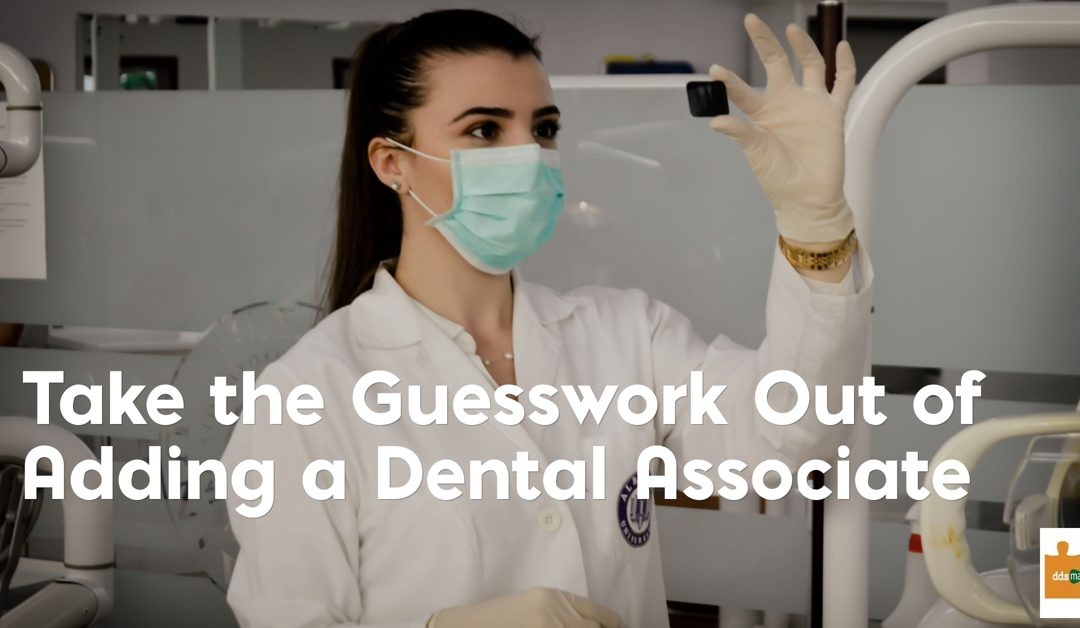If you are like most dentists, you want to get as much out of your practice as you can. When looking to increase production, most doctors will consider adding a dental associate, as another doctor in the office appears to be an easy way to boost production and revenue. Bringing on an associate can be good for a practice, especially as the owner-doctor begins considering transitioning the practice (read more about that here). However, it can be anything but easy. Before you get to the challenge of how to find and bring on the right associate, you first have to determine whether your practice can really support another doctor. Below, we discuss how you can be more certain about what your practice can handle before you decide.
Have Your Practice Evaluated
The first thing you should do is have your practice evaluated by an outside consultant, like a dental CPA. While you may have a sense of how strong your practice is, this is not an area where you want to guess or take chances. Hiring a doctor will be a strain on any practice—not only financially, but also in terms of the time to find, place, and train the associate; the impact on your staff in having to adjust to another doctor; and the added responsibility of managing another doctor, who will likely have less experience, but will have their own ideas about how to practice. Before taking all that on, you need to make sure that you, your staff, and your practice are ready for it.
An outside consultant will be in the best position to evaluate and report on whether your practice can bear the financial burden. Without this step, you can’t really be certain that an associate won’t create a drag on your practice. This could be disastrous for you and for the associate, who will definitely be worse off if you hire them without being able to afford them or if they are a bad fit for your office.
Here at DDSmatch Southwest, we work with our excellent partner dental CPAs on our proprietary Associate Intelligence Quotient (AIQ) process, which is invaluable in making this decision. More on that below.
But it’s not all on the word of the outside consultant. You should also look closely at your numbers and see what they tell you. Which brings us to the next step.
Know Your Patient Flow
A rule of thumb is that the average dental practice needs about one new patient for every $4,500 of total practice collections to maintain its current level of busyness. A caveat here, this number appears to be the one that generally works for this scenario, but this is only a broad guide, not an exact formula. And every practice is a bit different.
But for an initial consideration, you can determine your new patient flow by looking at how many new patients you’ve added in the last year and dividing your total practice collections by that number. For instance, if you collected $900,000 last year and added 180 patients, your collections are at about $5,000 per new patient. Using the $4,500 number, however, you would need to be adding about 200 new patients a year to maintain your current level of busyness. While 180 new patients is not far from 200 new patients, this exercise shows that, with these numbers, the practice does not have a surplus of new patients to support another doctor. Without some other factor that would increase production, a practice with this new patient flow would be unlikely to be able to comfortably add a dental associate.
What Does Your Schedule Look Like?
This question here is about how long it takes for a patient to get in to been seen at your office. Again, there is a rule of thumb in this case, but is only broadly accurate—your market may be different. The typical rule is that if a patient can schedule an appointment about 10 to 14 days out, your practice is at an equilibrium. If, periodically, your office is having to book patients 21 days out, you probably have a slight surplus of patients, but not likely enough to support an associate. If you are consistently scheduling patients 21 to 28 days out, that is an indicator that you don’t have the time to complete all the work that your office is attracting.
If you are in between equilibrium and a steady surplus, you may want to consider what you can do to increase your patient flow. This can be tricky, however, because when patients have to wait more than 28 days to book an appointment, chances are they will look for another dentist. But, until your practice has a steady stream of patients booking in the 21 to 28 day range, adding an associate will most likely have a negative impact on your level of busyness. The goal is to get your practice busy enough where you don’t experience any gaps in your schedule when the associate comes on.
How’s Your Hygiene?
How busy a practice is can be determined by two factors: new patient flow, discussed above, and the size of your hygiene department. The rule of thumb here is that for every $116,000 of doctor production, your practice will need one full day of hygiene per week. So, if your practice had a doctor production of $900,000 (not total collections) you would need about eight days of hygiene each week. If you already have two hygienists working four days a week, you are right where you should be. That’s good for your practice right now, but if you bring an associate and raise your doctor production, you may need to add a hygienist as well. That’s a big factor to be considered.
Consider Your Procedure Mix
Think about which procedures you perform, and which ones you refer out. Hiring an associate that is able to perform some of the procedures you now refer out can be a simple way to increase your overall production while not taking as much from your schedule. The principle here, as with the above considerations, is creating an excess: an excess of patients, of hygienists, and of services that can be done in-house. When you have those excesses, an associate can be a great asset to your practice. Remember, you don’t want an associate doing production that you could have done on your own.
Also, don’t limit yourself to only considering full-time associates. Depending on your practice and your market, maybe a part-time associate is a better choice. It doesn’t have to be all or nothing. Overreach in adding an associate will only bring dissatisfaction to all parties and less money in your pocket.
DDSmatch Southwest Can Help You In Adding a Dental Associate
As a dental broker, DDSmatch Southwest specializes in dental practice transitions, whether buying, selling, or expanding into new associates or new markets. Whether you are considering transitioning your practice or not, if you are thinking about adding a dental associate, you can take advantage of our Associate Intelligence Quotient (AIQ). This service involves the experts at DDSmatch Southwest, along with their dental CPA affiliates at Blue & Co., examining your practice and providing a detailed report that will show the impacts of hiring an associate. Why guess when you can know? Call DDSmatch Southwest today to find out your AIQ!

